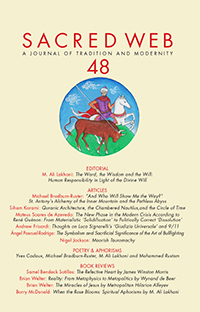Sacred Web will cease publication after issue 50
Sacred Web 48
Editorial:
The Word, the Wisdom and the Will: Human Responsibility in Light of the Divine Will
By M. Ali Lakhani
If all things are subject to the Divine Will, what scope is there for human responsibility, particularly during the spiritual entropy of the ‘End Times’? The Editorial examines this question by analyzing a passage from Ananda K. Coomaraswamy’s Farewell Address to the Harvard Club, and links it to the concept of ‘selving’ in the poetry of Gerard Manley Hopkins. Read more...
Articles
“And Who Will Show Me the Way?” St. Antony’s Alchemy of the Inner Mountain and the Pathless Abyss
By Michael Bradburn-Ruster
The experience of St. Antony of Egypt can be seen to exemplify an aspect of Sophia Perennis that deserves our keen attention, enhancing the familiar emblem of diverse paths leading up a mountain, only to converge at the summit; through various thematic parallels between Christianity, Islam, Judaism, Hinduism, Buddhism and Daoism, we find that whilst their ultimate unity remains transcendent, the immanence of the Divine ensures that there be many places where distinct paths providentially intersect. For height entails depth, as yang implies yin; any integral spiritual journey is ineluctably a dilation of the soul: to travel upward demands plunging within, until the outer and the inner, virtue and vision coalesce. Upon the soul’s dissolution in Spirit, the face of the Other is beheld as a mirror of our own, their mutual transparency reflecting the One Countenance; this is developed in the apophatic dimensions of Rheno-Flemish mysticism, and manifested in recent figures of Thomas Merton, St. (Mother) Teresa of Calcutta, and Dom Christian de Chergé. Read more...
Quranic Architecture, the Chambered Nautilus, and the Circle of Time
By Siham Karami
This essay presents a unique way of viewing the architecture of the Holy Quran, based on a geometer's understanding of its structure, and an esotericist's view of its symbolism.The author likens its structure to the shape of a chambered nautilus, and shows how, in the Quran’s own words, its presentation discloses insights into the nature of time and meaning, including a zodiac calendar used by ancient Arabs. Likening the nautilus to Noah’s ark, the author suggests that the Quran is a symbolic ark protecting those who “board” it. Each surah is part of an ordered whole, exhibiting zodiacal and metaphysical ‘signs’, and whose structure is designed to assist with memorization and interpretation. Read more...
The New Phase in the Modern Crisis According to René Guénon: From Materialistic ‘Solidification’ to Politically Correct ‘Dissolution’
By Mateus Soares de Azevedo
How can one understand the present widespread phenomenon of political correctness? Is it merely a new manifestation of that ‘ideological patrol’ that tries to stifle free debate and to impose itself urbi et orbi in the name itself of free debate? How should one characterize “political correctors”? Are they exclusivists in their demands for inclusivity? Homogenists in their demands for heterogeneity? Uniformists in their demands for diversity? Or is political correction a blitzkrieg against values accepted as good universally? Finally, is this ideological current a branch of Marxism, or Neo‐Marxism? Or is it, as expressed by French metaphysician René Guénon, a kind of post‐modern variant of ‘dissolution’? The article addresses these questions. Read more...
‘Thoughts on Luca Signorelli’s Giudizio Universale and 9/11’
By Andrew Frisardi
This personal essay, completed for the twentieth anniversary of the 9/11 terrorist attacks in New York and Washington, reflects on those events through the imagery of a famous fresco cycle by Luca Signorelli in the cathedral of Orvieto, Italy. Referring to notes written at that time, the author considers the frescoes as an occasion for reflecting on the world‐changing events that had just taken place. Read more...
The Symbolism and Sacrificial Significance of the Art of Bullfighting
By Ángel Pascual-Rodrigo
The bullfight, thought by some to be forbidden in Islam, is a tradition steeped in spiritual significance. This essay, by a Hispanic artist, draws on traditional metaphysics to explain the sacred heritage of bullfighting, its symbolism and nobility. The author, an artist who has devoted himself to the study and culture of bullfighting, vividly paints for the reader a portrait of both the experience and the meaning of the bullfight in an attempt to preserve its disappearing art and to challenge misconceptions about it. He shows, for example, that ‘cruelty’ is not involved in the proper practice of this ancient tradition. The essay is complemented by precious images and supplemented by a bibliography. Read more...
Note on the Cover Illustration
By Nigel Jackson
In this Note the artist explains some aspects of the symbolism of the cover illustration titled ‘Moorish Tauromachy’. Read more...
Poetry & Aphorisms
Three Gnostic Poems from A Book to Free the Soul
By Yves Cadoux
The Vacant Cross, A Poem for Gaza, for Syria, for Yemen
By Michael Bradburn-Ruster
Kneeling
By M. Ali Lakhani
Some Aphorisms on God, Evil, and Liberation
By Mohammed Rustom
Book Reviews
The Reflective Heart: Discovering Spiritual Intelligence in Ibn ‘Arabi’s Meccan Illuminations by James Winston Morris
Reviewed by Samuel Bendeck Sotillos
Reality: From Metaphysics to Metapolitics by Wynand de Beer
Reviewed by Brian Welter
The Miracles of Jesus by Metropolitan Hilarion Alfeyev
Reviewed by Brian Welter
When the Rose Blooms: Spiritual Aphorisms by M. Ali Lakhani with Illustrations by Nigel Jackson
Introduction by Barry McDonald



